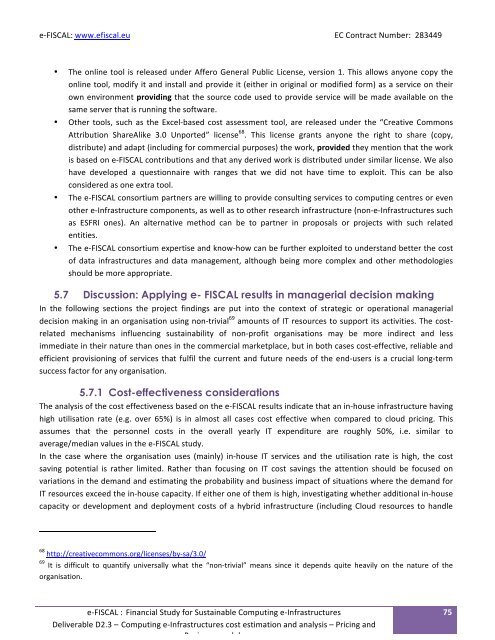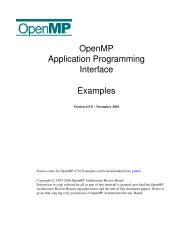D2 3 Computing e-Infrastructure cost calculations and business _models_vam1-final
D2 3 Computing e-Infrastructure cost calculations and business _models_vam1-final
D2 3 Computing e-Infrastructure cost calculations and business _models_vam1-final
Create successful ePaper yourself
Turn your PDF publications into a flip-book with our unique Google optimized e-Paper software.
e-‐FISCAL: www.efiscal.eu <br />
EC Contract Number: 283449 <br />
• The online tool is released under Affero General Public License, version 1. This allows anyone copy the <br />
online tool, modify it <strong>and</strong> install <strong>and</strong> provide it (either in original or modified form) as a service on their <br />
own environment providing that the source code used to provide service will be made available on the <br />
same server that is running the software. <br />
• Other tools, such as the Excel-‐based <strong>cost</strong> assessment tool, are released under the “Creative Commons <br />
Attribution ShareAlike 3.0 Unported” license 68 . This license grants anyone the right to share (copy, <br />
distribute) <strong>and</strong> adapt (including for commercial purposes) the work, provided they mention that the work <br />
is based on e-‐FISCAL contributions <strong>and</strong> that any derived work is distributed under similar license. We also <br />
have developed a questionnaire with ranges that we did not have time to exploit. This can be also <br />
considered as one extra tool. <br />
• The e-‐FISCAL consortium partners are willing to provide consulting services to computing centres or even <br />
other e-‐<strong>Infrastructure</strong> components, as well as to other research infrastructure (non-‐e-‐<strong>Infrastructure</strong>s such <br />
as ESFRI ones). An alternative method can be to partner in proposals or projects with such related <br />
entities. <br />
• The e-‐FISCAL consortium expertise <strong>and</strong> know-‐how can be further exploited to underst<strong>and</strong> better the <strong>cost</strong> <br />
of data infrastructures <strong>and</strong> data management, although being more complex <strong>and</strong> other methodologies <br />
should be more appropriate. <br />
5.7 Discussion: Applying e- FISCAL results in managerial decision making<br />
In the following sections the project findings are put into the context of strategic or operational managerial <br />
decision making in an organisation using non-‐trivial 69 amounts of IT resources to support its activities. The <strong>cost</strong>-related<br />
mechanisms influencing sustainability of non-‐profit organisations may be more indirect <strong>and</strong> less <br />
immediate in their nature than ones in the commercial marketplace, but in both cases <strong>cost</strong>-‐effective, reliable <strong>and</strong> <br />
efficient provisioning of services that fulfil the current <strong>and</strong> future needs of the end-‐users is a crucial long-‐term <br />
success factor for any organisation. <br />
5.7.1 Cost-effectiveness considerations<br />
The analysis of the <strong>cost</strong> effectiveness based on the e-‐FISCAL results indicate that an in-‐house infrastructure having <br />
high utilisation rate (e.g. over 65%) is in almost all cases <strong>cost</strong> effective when compared to cloud pricing. This <br />
assumes that the personnel <strong>cost</strong>s in the overall yearly IT expenditure are roughly 50%, i.e. similar to <br />
average/median values in the e-‐FISCAL study. <br />
In the case where the organisation uses (mainly) in-‐house IT services <strong>and</strong> the utilisation rate is high, the <strong>cost</strong> <br />
saving potential is rather limited. Rather than focusing on IT <strong>cost</strong> savings the attention should be focused on <br />
variations in the dem<strong>and</strong> <strong>and</strong> estimating the probability <strong>and</strong> <strong>business</strong> impact of situations where the dem<strong>and</strong> for <br />
IT resources exceed the in-‐house capacity. If either one of them is high, investigating whether additional in-‐house <br />
capacity or development <strong>and</strong> deployment <strong>cost</strong>s of a hybrid infrastructure (including Cloud resources to h<strong>and</strong>le <br />
68 http://creativecommons.org/licenses/by-‐sa/3.0/ <br />
69 It is difficult to quantify universally what the “non-‐trivial” means since it depends quite heavily on the nature of the <br />
organisation. <br />
e-‐FISCAL : Financial Study for Sustainable <strong>Computing</strong> e-‐<strong>Infrastructure</strong>s <br />
Deliverable <strong>D2</strong>.3 – <strong>Computing</strong> e-‐<strong>Infrastructure</strong>s <strong>cost</strong> estimation <strong>and</strong> analysis – Pricing <strong>and</strong> <br />
Business <strong>models</strong> <br />
75




